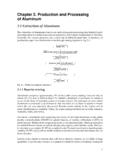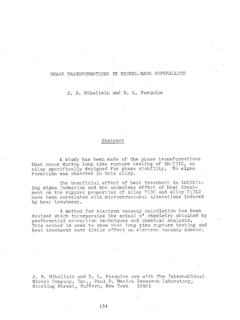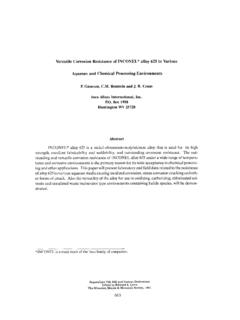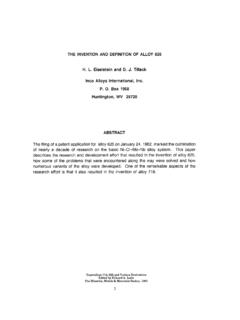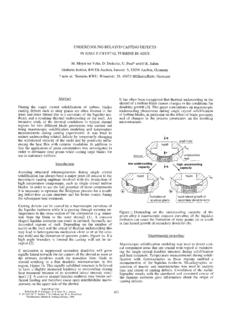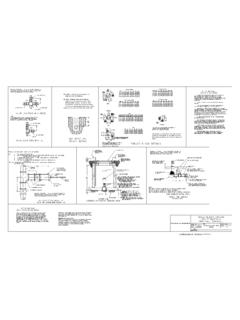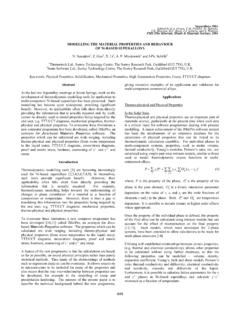Transcription of Gamma/Gamma-Prime Microstructure Formed by …
1 Gamma/Gamma-Prime Microstructure Formed BY PHASE separation OF gamma - prime PRECIPITATES IN A Ni-Al-Ti ALLOY Minoru Doi, Daisuke Miki, Tomokazu Moritani and Takao Kozakai Department of Materials Science and Engineering, Nagoya Institute of Technology Gokiso-cho, Showa-ku, Nagoya 466-8555, Japan Keywords: gamma - prime , Ni-base alloy, elasticity effect, precipitate coarsening, split Abstract The evolution of J/J Microstructure in elastically constrained alloy was investigated by means of transmission electron microscopy and the energy calculations based on a microelasticity theory. When the homogenized Ni-Al-Ti alloy is aged at 1213 K, cuboidal J precipitate particles appear throughout the J matrix.
2 When the J/J two-phase Microstructure is aged at 1023 K or 973 K, the phase separation takes place in eachJ precipitate and a number of J particles newly appear in the cuboidalJ precipitate. In the course of further ageing at 1023 K or 973 K, the J particles coarsen and become plates with surfaces parallel to {100}, then some J plates extend along one of {100} to become flatter, and finally reaches the J matrix surrounding the J precipitate. Not only the elastic energies but also the chemical free energy plays an essential role in this type of split as the driving force. The split takes place throughout the Microstructure although the volume fraction is high, which results in the occurrence of the decelerated coarsening of J/J two-phase Microstructure in an elastically constrained Ni-Al-Ti alloy.
3 IntroductionMany of the properties of Ni-base superalloys are originated from the phase-separated microstructures strengthened by coherent J particles. To obtain the Microstructure containing finely dispersed J precipitate particles, the phase transformation which takes place in the course of heat treatment is usually utilized. However, the desired Microstructure accompanied by useful properties is, in general, obtained by interrupting the heat treatment and hence by interrupting the phase transformation. Therefore, the desired J/J Microstructure is usually in a metastable state from the thermodynamic point of view, and the J particles change their shape, arrangement, size, etc.
4 To decrease their energy state towards the stable state. Furthermore, such coherent J/J systems are elastically constrained more or less, and hence the elastic energy arises from the lattice mismatch between J and J phases . Then the effects of elastic energies, the elasticity effects, sometimes become dominant enough to control the morphology of J precipitates. The present authors group has been pointing out the importance of the elasticity effects on the microstructures of alloy systems containing coherent precipitates [1-8]: J/J system of Ni-base alloys, B2/D03 system of Fe-base alloys, D-Ti/Ti3Al and TiAl/Ti3Al5 systems of Ti-Al alloys, etc.
5 Regarding the Ni-base alloys, the two-phase microstructures examined were mainly limited to those consisting of the disordered J matrix and the orderedJ precipitate phases . However, some studies have been reported on the two-phase microstructures in which J particles are dispersed in the J matrix of Ni-Al-Ti alloys [9,10]. In the present studies, the evolution of J/J Microstructure as a result of the phase separation of J precipitate particles in an elastically constrained Ni-Al-Ti alloy was investigated by means of transmission electron microscopy observations and the energy calculations based on a microelasticity theory.
6 Experimental Procedures alloy was used in the present studies. An ingot prepared with vacuum induction melting was hot-forged to obtain a rod specimen of 7 mm in diameter and mm in thickness. Each disc was solution-treated at a high temperature inside the single-phase region of J, and was subsequently quenched into iced brine. The solution-treated disc was aged at 1213 K followed by quenching into iced brine, and finally was aged at 1023 K or 973 K. Thin foil specimens for transmission electron microscopy (TEM) observations were obtained by electropolishing the aged discs in an electrolyte of and at 223 K.
7 The Microstructure evolution caused by ageing was observed by means of TEM and was also interpreted by theoretical calculations based on a microelasticity theory from the thermodynamic point of view. Since all the TEM images were taken with the 100 superlattice reflection of ordered J phase, the bright and the dark regions correspond to J and J phases respectively. TEM Observations Precipitation of J Particles in J Matrix Figure 1 illustrates the TEM image of cuboidal J precipitate particles in the J matrix of alloy which is solution-treated and then aged at 1213 K for sec.
8 Due to the ageing at 1213 K, the J phase Formed by solid-solution treatment separates into two-phase state of J+J and spherical J particles precipitate in the J matrix. In the course of further ageing at 1213 K, the J precipitate particles coarsen and the shape change from sphere to cuboid takes place due to the effect of elastic energy which arises from the lattice mismatch between J-matrix and J -precipitate [11]. Furthermore, the J particles are aligned along <100> directions, which is also seen in Fig. 1. The directional alignment of J particles is also a result of elastic energy and, in particular, of elastic interaction energy explained hereinafter.
9 109 Superalloys 2004 Edited by Green, Pollock, H. Harada,TMS (The Minerals, Metals & Materials Society), Howson, Reed, Schirra, and S, Walston Figure 1. TEM image of cuboidalJ precipitateparticles aligned along <100> directions inJmatrix of alloy aged at 1213 K of J Particles inJ PrecipitateFigure 2 illustrates the TEM images ofJ/J two-phase microstructures in alloy aged at 1023 K afterageing at 1213 K for sec. Due to the ageing at 1023 K,the phase separation of J precipitate phase takes place and anumber of J particles newly appear here and there in the cuboidalJ precipitates which act as the matrix for the phase separation .
10 Inthe course of ageing at 1023 K, the Jparticles coarsen and changetheir shape from cube to plate, and theJ particles become aligned along <100> directions. While further ageing at 1023 K, theJplates coarsen to become flatter in cuboidalJ precipitate andfinally some J plates elongate along {100} to reach theJ matrixsurrounding the J precipitate. This is just the split phenomenonofJ precipitate 3 illustrates the TEM images ofJ/J two-phase microstructures in alloy aged at 973 K after ageingat 1213 K for morphological change of Jparticles which newly appear in cuboidalJ precipitates isessentially the same as that caused by ageing at 1023 K: thesplit of J phase also takes place here and there throughout thetwo-phase Microstructure .

